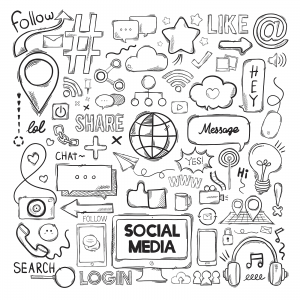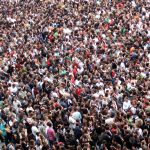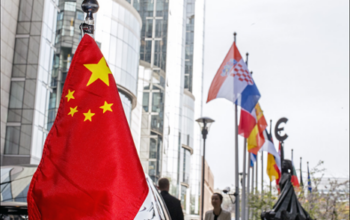Lying and misinterpretation. These are the things you think of first when you hear the concept of misinformation. However, if you take a different approach it could be said that misinformation does not come from being dishonest, but rather from an excessive amount of information.
Media Expansion
A few decades ago the main sources of information were written papers, radio and television, but over the years, the concept of news has expanded. Now they involve new media creating content and new meanings. Not only is there traditional literacy, but digital too. All information that is present can be digital at any time. People are becoming more involved in creating literacy, which can be a source of information for others.

Since the earlier days when the printing press was the dominant medium, only those who had access to it had the power of the written word, but now most people can spread their ideas freely. Today, organizations, politicians and other important people have social media accounts which gives citizens an opportunity to ask them questions directly, and to complain or share their concerns. Through this new open space of discussion, more opinions are put out without restriction or fact check. Moreover, with visual language being involved even more information is being provided. An infographic from WebDAM states that posts with added gifs, pictures, videos or even emojis get higher engagement than text-only posts. Overall, with the speed of life that society is functioning in nowadays, everyone is a participant of this information culture.
The whole concept of using different methods to communicate and share ideas on the internet has its own definition called netspeak. Cambridge Dictionary describes netspeak as “the words, abbreviations, etc. that people use when communicating on the internet”. With the help of new media technologies, there are more and more people who create literate content on social media, blogs, chats, comments, and articles every day.
How do we select useful information?

All the information we consume comes from various sources and in different forms and with even more comments and ideas attached to them. Back in 1990, Professors Michael McKenna and Richard Robinson introduced a concept of Content Literacy, which means the ‘ability to use reading and writing for the acquisition of new content in a given discipline’. This skill allows to provide material for the world daily. A study done by Dr. Martin Hilbert and his team at the University of Southern California shows that now, with 24-hour television, internet, and mobile phones, we receive five times more information every day than in 1986. Due to this, people could get easily misled. The only way not to get caught up with this information madness is to be knowledgeable about it.
Paul Gilster, the author of the book “Digital Literacy”, has said in an interview that digital literacy must be more than the ability to use digital sources effectively; it is a special kind of mindset or thinking. Literacy affected by new media could have multiple meanings behind it. Now that literacy also involves visual aspects, there are endless possibilities to understand text. People can interpret content transferred through technologies (TV, films, magazines, newspapers, games, internet, mobile phones, etc.) however they want to.
It can be hard to keep up with all information if we do not choose to analyze what we read. Political parties or high profile politicians usually use the help of professional writers to make their official statements, while some make ordinary post on social media. That way, after you read it or hear it, you might think the way it was purposely intended for you to think. Thus, it is really important to identify what information people can be relying on, otherwise choices could be influenced by the authorities. Over the years, the same concept of content literacy has changed and Professor Barbara Moss describes it as ‘Content area literacy is a cognitive and social practice involving the ability and desire to read, comprehend, critique and write about multiple forms of print ’. Therefore, content literacy is the ability to create information, but also a knowledge of how to find different meanings, intentions behind it which is a way to select useful material and not to get caught up with too much information.
Digital natives and digital immigrants
 This digital era, which brings us a massive amount of information daily, is not new for everyone. Digital natives, or people who were born in an age of technology, are already closely familiar with new media and digital literacy. They are already able to use different media channels, create content, understand meanings behind different text and has skills on writing in digital world. However, there are digital immigrants to whom all these new ways of viewing content was brought up as they were older, which means they are still adapting, learning to have essential skills in order to create the right content or select useful information. Since more people are born in the technology world, the generation gap between these groups is decreasing.
This digital era, which brings us a massive amount of information daily, is not new for everyone. Digital natives, or people who were born in an age of technology, are already closely familiar with new media and digital literacy. They are already able to use different media channels, create content, understand meanings behind different text and has skills on writing in digital world. However, there are digital immigrants to whom all these new ways of viewing content was brought up as they were older, which means they are still adapting, learning to have essential skills in order to create the right content or select useful information. Since more people are born in the technology world, the generation gap between these groups is decreasing.
Since new ways of receiving information are created every day, for new generations, it could still become difficult to stay updated. As a result, there is a possibility to have a big generation gap which prevents technologies from developing and that would stop new media and literacy from processing, because new mediums would not be created. In a case like this, misinformation could develop another concept which comes from the generation gap.
Mastering the (Mis)Information Overload
Information and the audience who are reacting to it, are a powerful tool which can change opinions or even actions. This means that with this big amount of content that we receive daily it is essential to be digitally literate and to understand news your own way. In order to progress and to be more open to the world, we should not be trying to stop ourselves from receiving information but rather gain abilities to recognize different meanings and intentions behind it. Misinformation or information overload only happens when certain knowledge, skills are not applied.
By Eligija Rukšytė
Pictures
by Freepik








